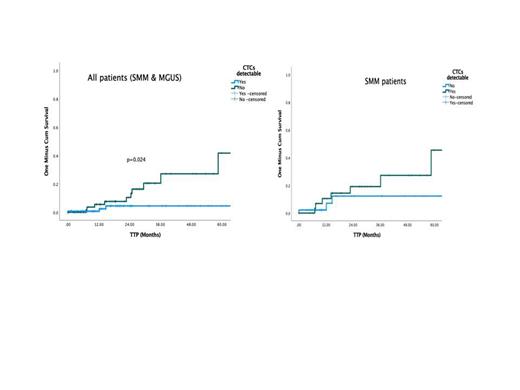Monoclonal gammopathy of undetermined significance (MGUS) and asymptomatic (smoldering) multiple myeloma (sMM) precede symptomatic myeloma (MM) but are characterized by significant heterogeneity in terms of biological characteristics and clinical course. Currently no single molecular or clinical feature can identify patients (pts) who should be treated immediately or for which treatment should be prioritized over watchful wait. Circulating tumor cells (CTCs - clonal plasma cells) are frequent in pts with symptomatic MM and have prognostic significance, independently of other disease and patient characteristics. The use of next generation flow cytometry (NGF) is an accurate method to assess CTCs and provides a non-invasive tool to assess tumor cells. Few studies have addressed the prognostic significance of CTCs detected by NGF as a potential prognostic biomarker in SMM. Herein, we report our initial results from the prospective evaluation of pts with asymptomatic plasma cell dyscrasias with NGF to determine baseline CTC values.
We prospectively analyzed the data and outcomes of 189 consecutive pts with asymptomatic monoclonal gammopathies (MGUS or SMM by IMWG criteria), diagnosed and followed in the Department of Clinical Therapeutics, Athens, which were evaluated prospectively for the detection of CTCs at the time of initial diagnosis. CTCs were assessed in peripheral blood (PB) according to the EuroFlow guidelines, using two independent 8-color panels, both containing CD19-PC7, CD27-BV510, CD38-FITC, CD45-PerCPCy5.5, CD56-PE, CD138-BV421, and additionally CD117-APC and CD81-APCC750 only in the surface tube or CyIgκ-APC and CyIgλ-APCC750 only in the intracytoplasmic tube. A median number of 5 million events (range 3.9x106-6.1x106) were acquired for each tube and median LOD was 2.3x10-6 (range 2x10-6- 3.1x10-6).
The median age of the cohort's pts was 65 years (range 28-87) and 59% were females; 47% had non-IgM MGUS and 53% had a diagnosis of SMM. The isotype was IgG in 85% and 74%, IgA in 10% and 22% and light chain only in 2% and 4% in MGUS and SMM pts respectively. Among MGUS pts, 50% had abnormal FLC ratio and the median M-spike was 0.54 gr/dl (range: 0-1.96). For pts with SMM, 58% had abnormal FLC ratio, 16% had FLC ratio >20, 13% had M-spike >2 gr/dl and 31% had BM plasma cell infiltration >20%.Per IMWGs 20/2/20, 55% were low risk (no risk factors), 33% intermediate risk (one risk factor) and12% were high risk (2-3 risk factors). Cytogenetics were available in 60 pts (19 MGUS and 41 SMM): t(4;14) was present in 10% of SMM, t(11;14) in 22% of SMM and MGUS, t(14;16) in 8% if SMM, +1q21 in 31% of SMM and 6% of MGUS, del17p in 2% of SMM and 5% of MGUS (one patient each) and del13q in 29% of SMM and 17% of MGUS.
Clonal plasma cells (CTCs) were detectable in 33% of patient in the cohort: in 17% of MGUS and in 42% of SMM pts. Among those with detectable CTCs, median level was 0.004% (range 0.0002% to 0.22%) and did not differ among MGUs and SMM pts. Among pts with low-risk SMM, 31% had detectable CTCs (median 0.0065%) vs 45% of pts with intermediate/high risk (median 0.0022%) (p=0.066).
The median follow-up of the whole cohort is 18 months; until the data cutoff date 13pts have progressed (all with SMM); the 2-year progression rate 7%,29% and 46% for low, intermediate and high risk SMM (p=0.032)
The presence of CTCs was associated with a higher risk of progression to symptomatic MM among all pts in the cohort (HR: 4; 95% CI 1.1-14.7, p=0.024); among SMM pts there was a trend for shorter time to progression but did not reach statistical significance probably due to relatively short follow up and small numbers. We also evaluated 0.015% as a CTCs cutoff(identified previously by Termini et al) but only 10pts had CTCs above this level and did not reach statistical significance. Adjusted for IMWG 20/2/20 risk score, the presence of CTCs was associated with a trend towards statistical significance (HR: 3, 95% 0.97-11.9, p=0.104).
In conclusion, CTCs are detectable in about 33% of pts with asymptomatic monoclonal gammopathies, both in MGUS (in 17%) and more frequently in SMM (in 42%) pts. Their presence is associated with a trend towards increased risk of progression to symptomatic disease for SMM, but needs longer follow up to identify the role of CTCs in MGUS and the additive information over available risk stratification tools, which could provide an non-invasive, easy-to-follow longitudinally biomarker.
Disclosures
Kastritis:Sanofi: Honoraria; GSK: Honoraria, Research Funding; Pfizer: Honoraria, Research Funding; Janssen: Honoraria, Research Funding. Migkou:Integris Pharma: Honoraria; Glaxo Smith Klein: Honoraria; Janssen-Cilag: Honoraria. Gavriatopoulou:X4 Pharmaceuticals: Research Funding; Karyopharm: Honoraria, Research Funding; GSK: Honoraria; Takeda: Honoraria, Membership on an entity's Board of Directors or advisory committees; Janssen: Honoraria, Membership on an entity's Board of Directors or advisory committees; Amgen: Honoraria, Membership on an entity's Board of Directors or advisory committees; Celgene/Genesis: Honoraria; Sanofi: Honoraria. Terpos:Amgen: Honoraria, Other: Travel Expenses, Research Funding; BMS: Honoraria; ASTRA/Zeneca: Honoraria, Other: Travel Expenses; EUSA Pharma: Honoraria, Other: Travel expenses; GSK: Honoraria, Research Funding; Janssen: Honoraria, Research Funding; Menarini/Stemline: Honoraria; Pfizer: Honoraria; Sanofi: Honoraria, Other: Travel expenses, Research Funding; Takeda: Honoraria, Other: Travel expenses, Research Funding.


This feature is available to Subscribers Only
Sign In or Create an Account Close Modal